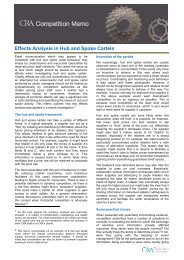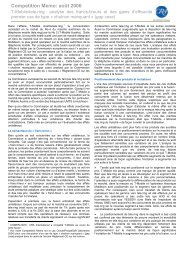CUSTOMER AGREED REMUNERATION - CRA International
CUSTOMER AGREED REMUNERATION - CRA International
CUSTOMER AGREED REMUNERATION - CRA International
You also want an ePaper? Increase the reach of your titles
YUMPU automatically turns print PDFs into web optimized ePapers that Google loves.
REPORT BY <strong>CRA</strong> INTERNATIONAL<br />
Figure 10 Impact on the use of nationals, networks and service providers<br />
% of intermediaries<br />
100%<br />
90%<br />
80%<br />
70%<br />
60%<br />
50%<br />
40%<br />
30%<br />
20%<br />
10%<br />
0%<br />
Nationals Network members Non-network/national IFAs<br />
Continue to use a network, national or service provider<br />
Join a network, national or service provider<br />
Would not use a network, national or service provider<br />
Source: <strong>CRA</strong> <strong>International</strong> based on survey of 101 intermediaries conducted by ORC <strong>International</strong>.<br />
Figure 10 shows that the application of CAR could have a significant impact on the<br />
incentive for intermediaries to be a member of a network or national or to use a service<br />
provider. Although based on a small sample, this would suggest that national IFAs are<br />
more likely to consider changing their membership than networks.<br />
Some service providers are already moving away from a model where the price that they<br />
are paid for their services is based on a proportion of the commission earned, and<br />
towards a monthly fee according to the services that they receive. It seems that those<br />
service providers who have acted in this way will be less affected by changes in<br />
remuneration levels or structures caused by CAR.<br />
Alternatively, networks, nationals and service providers could use their bargaining power<br />
to negotiate better terms from the manufacturers for the consumer i.e. lower<br />
manufacturing prices.<br />
In well functioning markets, bargaining power of intermediaries or distributors is used in<br />
order to offer better value products or services to customers. Thus as well as competition<br />
over administration and service, we would expect to see bargaining power leading to<br />
some intermediaries being able to obtain products from providers at lower manufacturing<br />
prices than other intermediaries. Both the lower manufacturing price and the cost of<br />
advice would be disclosed to clients hence, if competition works well, large intermediaries<br />
would be able to use their buying power to the direct advantage of their clients.<br />
Discussions with large intermediaries indicate that this is the direction that competitive<br />
forces would be expected to move. However, interviews with providers indicate<br />
reluctance to offer different products with different underlying prices. In some firms it<br />
appears as though the setting of manufacturing prices is currently undertaken separately<br />
from the negotiation of commission levels with intermediaries and therefore negotiation of<br />
manufacturing prices has not been contemplated in the past.<br />
30




